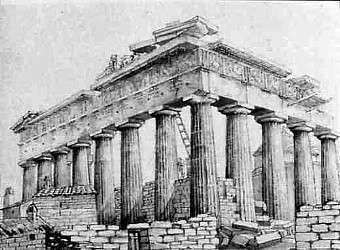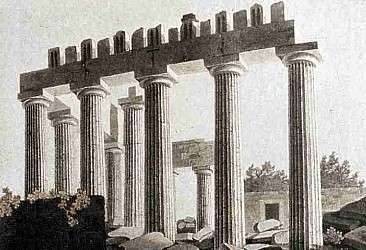Elgin's

Elgin as a young man
At the end of the eighteenth century Louis Francois Sebastien Fauvel was sent by the French Ambassador to Athens to collect antiquities and send them back to France. This he was able to do by bribing the local Ottoman authorities and he amassed an impressive collection. He requested again and again to take parts of the Parthenon but he was always refused by the Turkish government. When Turkey went to war with France, like other Frenchmen he was put into prison and his collection locked away.
In August of 1800 Lord Elgin's crew led by Reverend Philip Hunt and the Italian Giovani Batista Lusieri, a professional landscape painter in charge of the whole project, arrived to draw, mold and measure. However, because the Acropolis was a military installation they could not get permission from the military governor to go up there. They spent that time drawing and measuring the other monuments in Athens. Finally after 6 months they were able to bribe the governor and were permitted to begin the work but just as they were about to do the moldings of the Parthenon sculptures they were denied entrance and forbidden to set foot on the Acropolis because of rumors of a French invasion. Since the Acropolis was the fortress that was supposedly protecting the city not even bribes could help. What they needed was a special firman, an official letter from the Sultan in Constantinople that would give them permission to continue their work.
On June 17th 1801 the French surrendered Cairo. On July 6th the Ottoman government, enamored with the British for defeating the French, supposedly gave Lord Elgin his firman, giving his crew the right to enter the Acropolis without hindrance or bribes and to erect scaffolding, draw, make molds, remove obstructions, excavate and to take away anything of interest. (There was nothing about removing sculptures or damaging buildings). The Firman was delivered to the Viavode of Athens and the British hired Greek laborers to help them collect the pieces of marble laying around the Acropolis. But collecting inscriptions and pieces of broken statues was not enough and soon with the permission of the Viavode, Lord Elgin's men and the Greek workers were taking down the metopes from the Parthenon, bringing them to the British Consulate where drawings were made. They were then taken down to Piraeus and put on a ship. Why the Viovode allowed Lord Elgin to go beyond what was allowed in the firman is not really understood. Maybe he was just eager to please. But most likely once Lord Elgin realized how easily bribe-able the Ottoman authorities were he decided that there was no need to limit his artists to molding and sketching when they could just take it all back to England, and from that point on they removed everything from the Parthenon that was removable. Their reasoning was that had they not then someone else would have and in bringing these pieces back to England they were protecting history as well as vitalizing the arts at home. The Greeks and the Turks were all eager to help and to sell the ancient fragments that were built into their houses and walls. While the local Greeks did not have a clear idea of what the marbles were or their connection with the glorious past they did have the belief that they were endowed with spirit or Arabim. The workers claimed they could hear the groaning of these arabim imprisoned within the cases as they were being loaded on to the ships.

Parthenon before Elgin.
There were few objections though some visitors looked on in horror and practically wept at what they were witnessing, but work continued with Hunt and Lusieri encouraged by Lord Elgin from Constantinople. They even planned to dismantle the entire Erechthion and take it back to England so people could see for themselves the beautiful Porch of the Maidens but the British navy did not have a big enough boat available at the moment so they had to be satisfied with removing one of the Caryatids which they replaced with a brick pillar. They also considered taking the monument to Lysicrates but it was property of the Capuchin Monastery. In the meantime Elgin sent Phillip Hunt around the mainland looking for more pieces to bring back to England. They were only interested in pieces from the 5th century, the peak of the classical period and many works from other periods were not taken or drawings even made.
The important thing to realize is that the frieze and the metopes of the Parthenon were built to stay up forever. There was no way to take them down without destroying the building and much of the magnificent cornice work and marble masonry was smashed into smithereens.
During all this time Lord Elgin had not even been to Athens or seen any of the pieces that were being taken down, packed and shipped to England. When he did finally come to Athens in the spring of 1802 he was excited about the work and urged his men to continue to remove everything of value and that he would find more money to support their noble efforts. By summer they had taken everything they wanted from the Acropolis and Lord Elgin and his wife traveled around Greece finding new places to dig and collect artifacts. When he sailed back to Constantinople he left enough cash and gifts with his agents to bribe every Turkish official in Athens, which was necessary since there were many pieces scattered around that would add to his treasure.

Parthenon after Elgin
Thank you to Matt Barret, for permission to reprint Parthenon Marbles sections from his master web-site at
http://www.greecetravel.com/
This is also a very valuable site for traveller's/tourists to Greece.